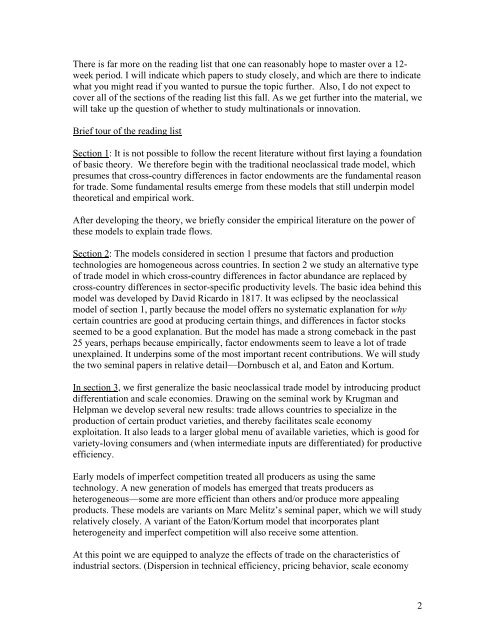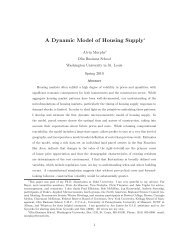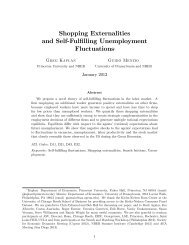1 J. Tybout Economics 507a: International Trade Lecture 1 I ...
1 J. Tybout Economics 507a: International Trade Lecture 1 I ...
1 J. Tybout Economics 507a: International Trade Lecture 1 I ...
- No tags were found...
Create successful ePaper yourself
Turn your PDF publications into a flip-book with our unique Google optimized e-Paper software.
There is far more on the reading list that one can reasonably hope to master over a 12-week period. I will indicate which papers to study closely, and which are there to indicatewhat you might read if you wanted to pursue the topic further. Also, I do not expect tocover all of the sections of the reading list this fall. As we get further into the material, wewill take up the question of whether to study multinationals or innovation.Brief tour of the reading listSection 1: It is not possible to follow the recent literature without first laying a foundationof basic theory. We therefore begin with the traditional neoclassical trade model, whichpresumes that cross-country differences in factor endowments are the fundamental reasonfor trade. Some fundamental results emerge from these models that still underpin modeltheoretical and empirical work.After developing the theory, we briefly consider the empirical literature on the power ofthese models to explain trade flows.Section 2: The models considered in section 1 presume that factors and productiontechnologies are homogeneous across countries. In section 2 we study an alternative typeof trade model in which cross-country differences in factor abundance are replaced bycross-country differences in sector-specific productivity levels. The basic idea behind thismodel was developed by David Ricardo in 1817. It was eclipsed by the neoclassicalmodel of section 1, partly because the model offers no systematic explanation for whycertain countries are good at producing certain things, and differences in factor stocksseemed to be a good explanation. But the model has made a strong comeback in the past25 years, perhaps because empirically, factor endowments seem to leave a lot of tradeunexplained. It underpins some of the most important recent contributions. We will studythe two seminal papers in relative detail—Dornbusch et al, and Eaton and Kortum.In section 3, we first generalize the basic neoclassical trade model by introducing productdifferentiation and scale economies. Drawing on the seminal work by Krugman andHelpman we develop several new results: trade allows countries to specialize in theproduction of certain product varieties, and thereby facilitates scale economyexploitation. It also leads to a larger global menu of available varieties, which is good forvariety-loving consumers and (when intermediate inputs are differentiated) for productiveefficiency.Early models of imperfect competition treated all producers as using the sametechnology. A new generation of models has emerged that treats producers asheterogeneous—some are more efficient than others and/or produce more appealingproducts. These models are variants on Marc Melitz’s seminal paper, which we will studyrelatively closely. A variant of the Eaton/Kortum model that incorporates plantheterogeneity and imperfect competition will also receive some attention.At this point we are equipped to analyze the effects of trade on the characteristics ofindustrial sectors. (Dispersion in technical efficiency, pricing behavior, scale economy2
















